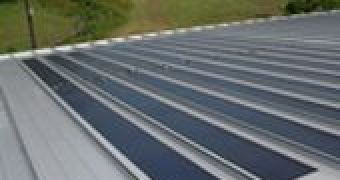For the first time in the Unites States, a house got its official Passive House certification thanks to “peel and stick” solar laminates. This system was made by Whirlwind Solar and it was installed on the house with help from architecture professor from the University of Louisiana, Corey Saft and H.J. Construction.
These laminates are build to fit between the ridges of common metal roofing systems. This seems very logic, as the company that builds them is part of Whirlwind Steel Buildings Inc., a metal buildings manufacturer since 1950's. These panels stick to the metal roof and are connected to an inverter that transforms the DC current into AC current, supplying power for the house. The very light panels absorb red, blue and green light from the sun rays, which are deposited in different layers of the flexible amorphous silicon solar cells. These silicon solar cells are less efficient that crystalline solar cells, but their price is lower and they do not need a special positioning for reaching maximum efficiency. The amorphous panels can be installed on every building-top, being a more economic solution than crystalline cells.
The Passive House certification did not rely only on the roof. The house has a complex energy-saving system. Its insulation is as effective as a thermos' and its air conditioning system is very efficient. It is also equipped with an air-to-water pump, an energy recovery ventilator and a rain-screen system for shading. Building such a house demanded high expertise but ultimately, any contractor or DIY can built it.
These solar laminates are perfect for people who want to live off-the-grid. From what it was believed to be a trend, it became a necessity for people or companies that want to reduce costs and waste less energy. The American Military has also adopted the off-grid for its buildings, insuring its energy independence and security.
Whirlwind is one of the largest manufacturers of metal buildings in the US, with four factories in Oklahoma, Georgia, Texas and Minnesota.

 14 DAY TRIAL //
14 DAY TRIAL //